Academic Leader: Wang Yang, PhD of Engineering, Associate Professor, Visiting Scholar at China Agricultural University (Supervisor: Professor Hongwen Li). He currently serves as a member of the Education Committee of the Chinese Society of Agricultural Engineering, a member of the Hill and Mountain Area Agricultural Machinery Branch of the Chinese Society of Agricultural Machinery, a member of the Youth Working Committee of the Chinese Society of Agricultural Machinery, a member of the Machinery Specialty Committee of the Chinese Society of Tropical Crops, and a board member of the Mechanization Innovation Alliance of Tropical and Subtropical Crops. He primarily focuses on the research and development of vertical ultra-deep rotary tillage (powder ridging), sugarcane, cassava, rice subtropical intelligent agricultural equipment, and agricultural robots. He has led and participated in 21 research projects, including two funded by the National Natural Science Foundation of China, one major Guangxi scientific and technological project (international cooperation), and five provincial projects. He has published 25 papers as the first author or corresponding author in SCI/EI journals. He has obtained one provincial-level identified achievement, six invention patents, and five utility model patents.
Phone: 13557210593
Key Members:
Yiqi Huang (PhD, Associate Professor, graduated from Nanjing Agricultural University)
Jingping Lu (PhD, Associate Professor, graduated from Chongqing University)
Zhiheng Lu (PhD, Assistant Professor, graduated from China Agricultural University)
Biao Zhang (PhD, Assistant Professor, graduated from Jilin University)
Mingzhang Pan (PhD, Professor, graduated from Tianjin University)
Xian Zheng (Master, Engineer, graduated from Guangxi University)
Research Focus:
1. Full-cycle sugarcane production machinery
(1) Vertical Ultra-Deep Rotary Tillage (Powder Ridge) Machinery
Addressing the main issues in current vertical ultra-deep rotary tillage, such as uneven soil fragmentation in the vertical direction (larger clods on top and smaller below), high operational energy consumption, and significant mechanical vibrations, the team has been collaborating with Guangxi Wufeng since 2015. This partnership has led to pioneering research on drag reduction and optimization for vertical ultra-deep rotary tillage tools. The first international paper on vertical ultra-deep rotary tillage machinery was published, providing a detailed explanation of the operational mechanics of these tools and laying a critical foundation for tool optimization. This research has been continuously supported by the National Natural Science Foundation of China and the Guangxi Natural Science Foundation.
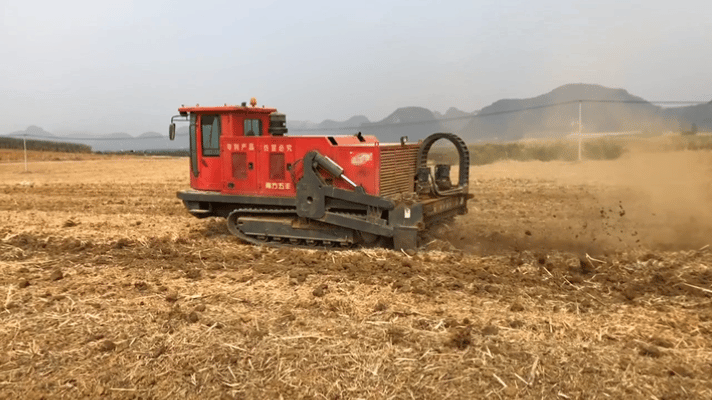
Vertical Ultra-Deep Rotary Tillage Machine (2021)
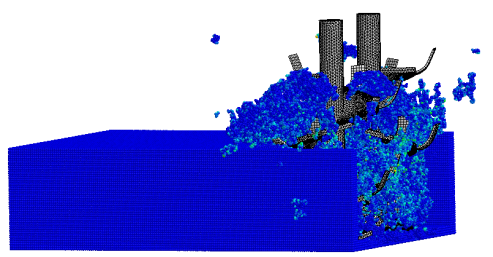
Simulation of Vertical Ultra-Deep Rotary Tillage Operations
In 2023, the team independently developed a small, low-resistance vertical ultra-deep rotary tillage machine suitable for China's sugarcane fields. When operating at a depth of 40cm, the new tool reduced the unit width operational resistance by 18% compared to that of Wufeng, and it continues to be optimized.
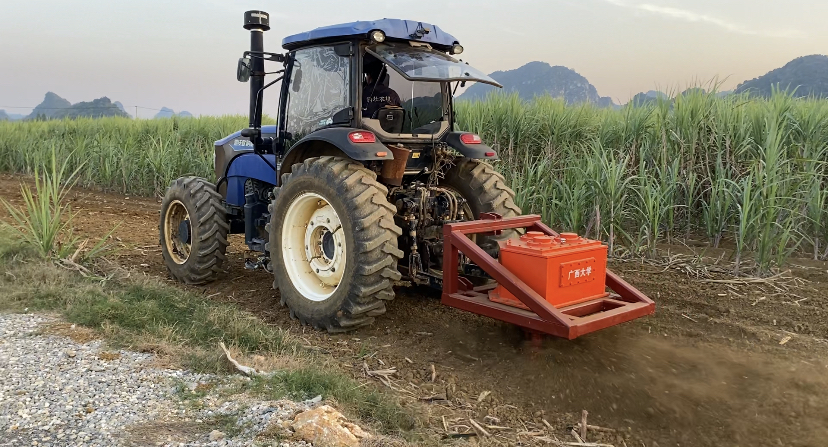
Vertical Ultra-Deep Rotary Tillage Machine (2023, Independently Developed)
(2) Planting Machinery
Supported by the Guangxi Natural Science Foundation project, efforts were made to reduce sugarcane cutting damage to buds and to enhance planting precision. Services for mechanized planting technologies with different bud types and coating mechanization were provided. The main task was to complete the collection of stem node images from the three main types of sugarcane in Guangxi. A model was established to define the relationship between sugarcane, the conveyor system, the cutter, and camera positioning. The features of sugarcane stem node images and the criteria for identifying node characteristics were proposed. The Radon function was used to extract linear edges of the sugarcane stem nodes, revealing the distribution pattern of linear pixel positions in the images.

Sugarcane cutting stem node identification
Addressing the current issues of uneven seed distribution and high bud damage rates in planters, since 2016, an innovative design has been developed for the key component of the planter, the seed distributor. This led to the creation of three generations of dual-bud sugarcane section distributors, capable of achieving high-speed, uniform seed distribution at a rate of 2.5 sugarcane sections per second and 1-2 sections per cycle.
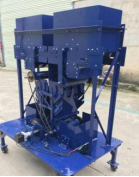
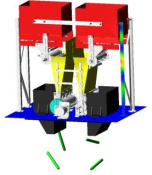
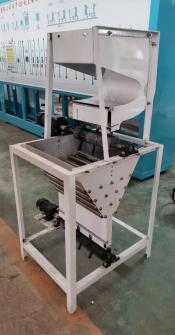
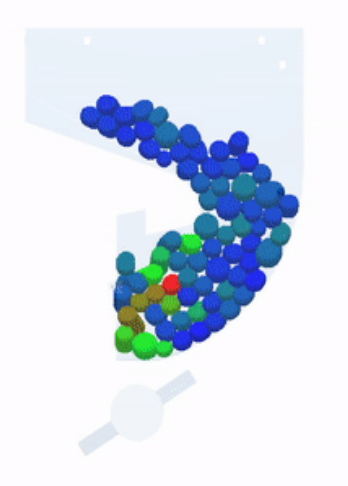
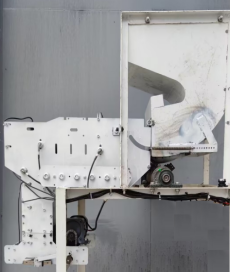

First-generation seed distributor Second-generation seed distributor Third-generation seed distributor
(3) Harvesting Machinery
Since 1998, supported continuously by the National Natural Science Foundation and the Guangxi Natural Science Foundation projects, research has been conducted in long-term collaboration with the Guangxi Agricultural Machinery Research Institute on the low cutting quality and high impurity rates issues of sugarcane harvesters. The research focused on the complex mechanisms of the cutter and impurity removal, and optimizations were made to the sugarcane cutting and debris removal systems.

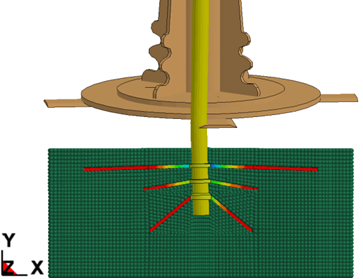
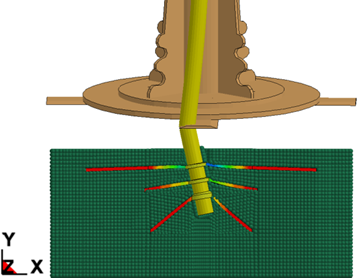
Sugarcane harvesting cutting simulation
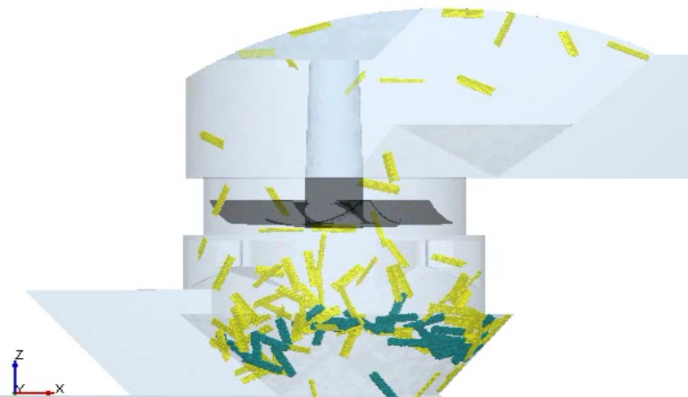
Sugarcane debris removal system operation simulation
In recent years, development has been carried out on modular sugarcane harvesting equipment. We have completed two projects funded by the National Natural Science Foundation and the Guangxi Science Foundation, and one key R&D project in Guangxi is underway. The results are being applied to the development of a traction-type sugarcane leaf stripper. Plans are in place to establish ten demonstration bases in Liuzhou for the 2024-2025 crushing season.
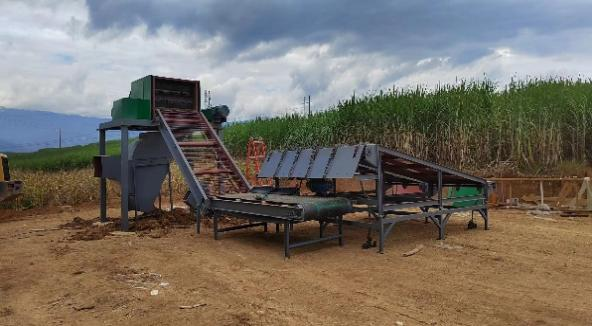
Modular Sugarcane Debris Removal Device
2. Bionic Intelligent Cassava Harvesting Machine
Since 2009, supported by national fund projects, Guangxi’s major science and technology special projects (ASEAN international cooperation projects), and the key laboratory projects of the Guangxi Science and Technology Department, research has been conducted on the cassava growth conditions representative of Guangxi. Focused on the hilly regions, groundbreaking research in the design theory of bionic cassava harvesting machinery has been initiated. This has led to the publication of 24 papers, 14 of which are indexed in SCI/EI, the granting of 5 invention patents, and the development of four generations of prototype machines. A new design theory for cassava harvesting machinery has been established.
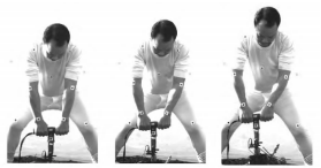
Human harvesting cassava (high-speed imaging)

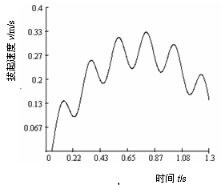
Speed of human cassava pulling

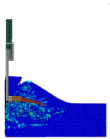
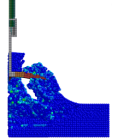
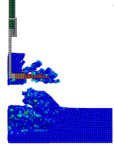
Bionic pulling mechanism cassava pulling simulation

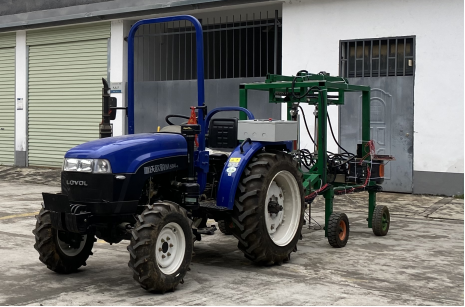
Fourth generation bionic intelligent digging and pulling harvester
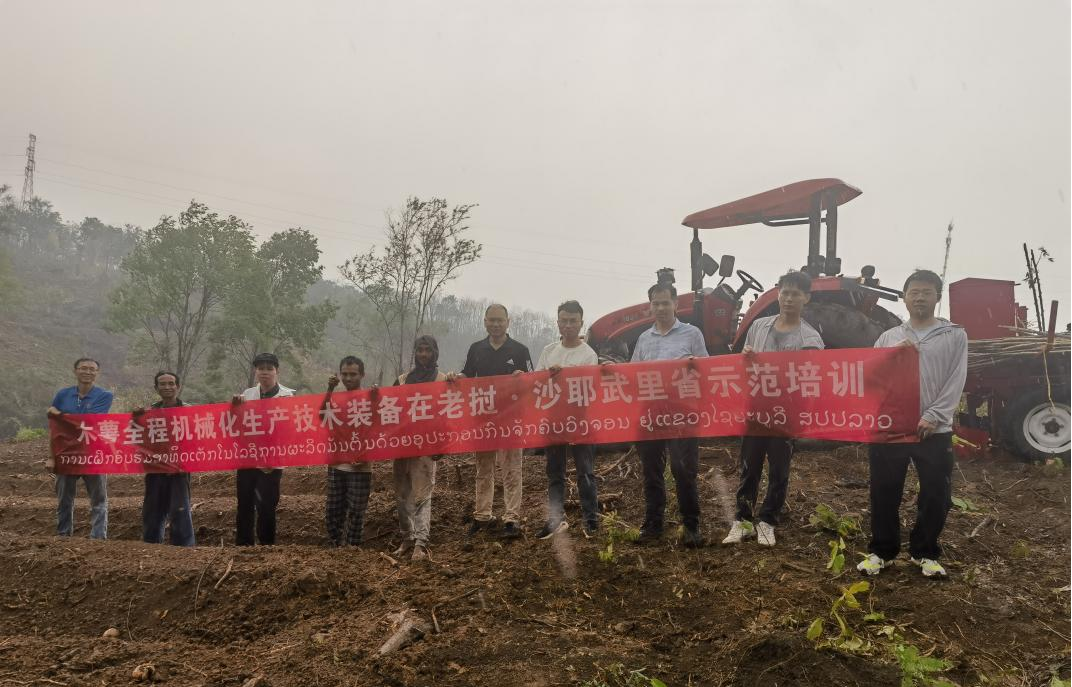
Promotion and application of developed cassava machinery in ASEAN countries
3. Electromagnetic Vibrational Rice Planting Machinery
In response to the uneven seeding and high damage rates in rice planting machinery, a series of research on electromagnetic vibrational rice planting machinery was conducted. The following were developed: a rice electromagnetic vibrational ring-type seeder (1993) (a global innovation), an 8-row rice electromagnetic vibrational direct seeder (1998) (well-known in the national agricultural machinery community, and was promoted in a certain area of southern Guangxi), an electromagnetic vibrational rice transplanter (2000), and an electromagnetic vibrational rice field mixing and seedling sowing machine (2013) (a leader in China).
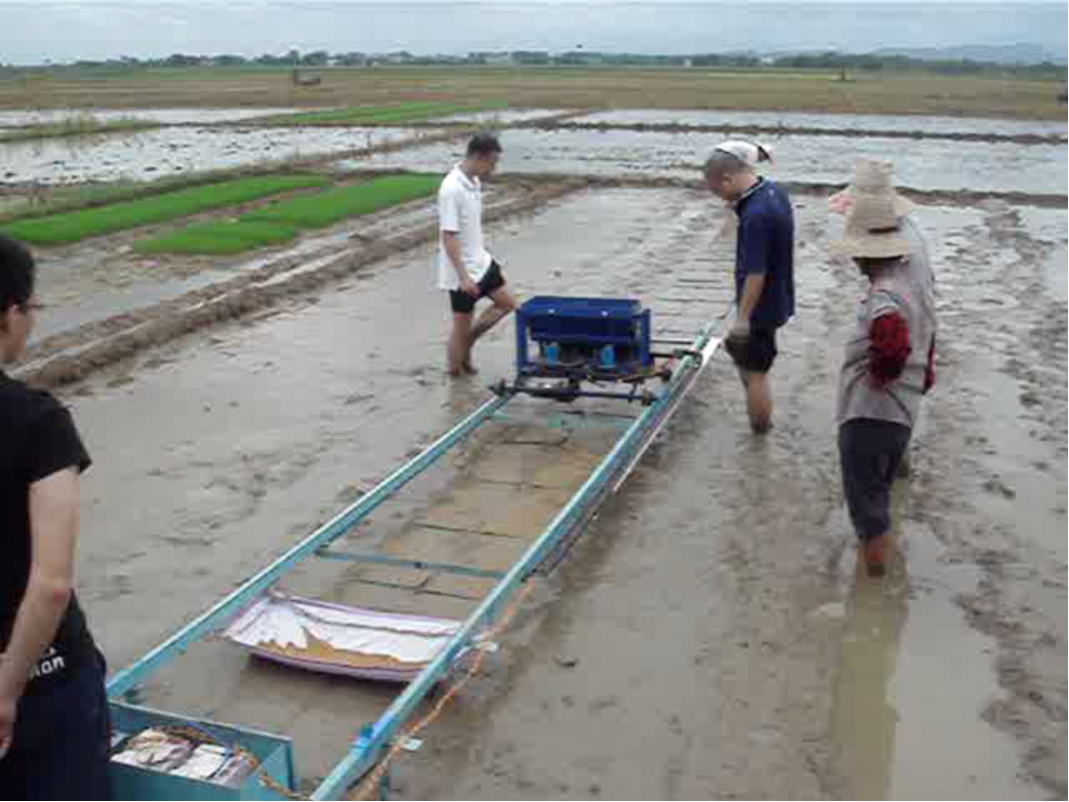
Field mixing and seedling sowing machine
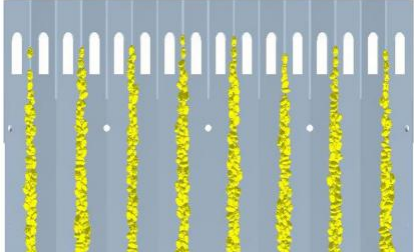
Electromagnetic vibrational seeder seeding simulation
Research Achievements:
In recent years, the advanced intelligent agricultural machinery team has focused on the developmental needs of agricultural mechanization in Guangxi. They have conducted scientific research in the areas of sugarcane full-cycle production machinery, cassava harvesting machinery, and rice planting machinery. By applying advanced design theories and methods, they have solved a series of key technical and fundamental theoretical challenges. This led to the development of prototypes such as the vertical ultra-deep rotary tillage (powder ridge) machine, sugarcane planter, cassava harvester, and direct rice seeder. The team has led 40 research projects, including 6 national funds and 25 provincial-level projects. They have published 42 SCI and EI papers and received 21 invention patent grants.
Research Articles:
(1) Wang Yang et al. Simulation of forces acting on the cutter blade surfaces and root system of sugarcane using FEM and SPH coupled method[J]. Computers and Electronics in Agriculture, 2021. (SCI)
(2) Wang Yang et al. Numerical simulation of spiral cutter-soil interaction in deep vertical rotary tillage[J]. Agriculture, 2023. (SCI)
(3) Wang Yang et al. Embedded field stalk detection algorithm for digging–pulling cassava harvester intelligent clamping and pulling device[J]. Agriculture, 2023. ( SCI)
(4) Wang Yang et al. Effect of root-soil parameters on the lodging resistance of sugarcane (Saccharum officinarum L.) [J]. Applied Ecology and Environmental Research, 2020. (SCI)
(5) Wang Yang et al. Numerical simulation of an experienced farmer lifting tubers of cassava for designing a bionic harvester[J]. CMES-computer modeling in engineering & sciences, 2015. (SCI)
(6) Wang Yang et al. Optimized tuber-lifting velocity model (TLVM) for cassava harvester design[J]. Advances in Mechanical Engineering, 2018. (SCI)
(7) Yiqi Huang et al. Evaluating Data Augmentation Effects on the Recognition of Sugarcane Leaf Spot[J]. Agriculture, 2023. (SCI)
(8) Yiqi Huang et al. Rresearch on sugarcane seed-bud location based on anisotropic scaling transformation[J]. Applied engineering in agriculture, 2022. (SCI)
(9) Yiqi Huang et al. Hyperspectral Imaging for Identification of an Invasive Plant Mikania micrantha Kunth[J]. Frontiers in plant science, 2021. (SCI)
(10) Yiqi Huang et al. UAV and a deep convolutional neural network for monitoring invasive alien[J]. Computers and electronics in agriculture, 2020. (SCI)
(11) Zhiheng Lu et al. UAV and a deep convolutional neural network for monitoring invasive alien[J]. Computers and electronics in agriculture, 2020. (SCI)
(12) Zhiheng Lu et al. Automatic teat detection for rotary milking system based on deep learning algorithms[J]. Computers and electronics in agriculture, 2021. (SCI)
(13) Biao Zhang et al. Design and experiment of profiling furrow-ridge terrain by cane leaf-chopping and returning machine[J]. Agriculture, 2024. (SCI)
(14) Biao Zhang et al. A DEM-MBD based method for regulating transfer flux in the supply and discharge of cane seed particles[J]. Computers and electronics in agriculture, 2024. (SCI)
(15) Yiqi Huang et al. Identification of Early Wheel Spot and Rust on Sugarcane Leaves Based on Spectral Analysis[J]. Transactions of the Chinese Society for Agricultural Machinery, 2023. (EI)
(16) Yiqi Huang et al. Gradient-based method for the identification of multi-nodes in sugarcane[J]. Information Processing in Agriculture, 2020. (EI)
(17) Wang Yang et al. Numerical Simulation of Digging Operation of Cassava Root
Planted in Red Clay[J]. Journal of Mechanical Engineering, 2013. (EI)
(18) Wang Yang et al. Optimization of tuber lifting velocity of cassava harvester based on improved spider clustering algorithm[J]. Transactions of the Chinese Society of Agricultural Engineering, 2018. (EI)
(19) Wang Yang et al. Simulation and test on performance of soil-cassava jitter separation device of cassava harvester[J]. Transactions of the Chinese Society of Agricultural Engineering, 2017. (EI)
(20) Wang Yang et al. Mechanical and mathematical model analysis of uprooted force
on cassava storage root[J]. Transactions of the Chinese Society of Agricultural Engineering,2011. (EI)
(21) Wang Yang et al. Dynamic simulation experiment on effects of sugarcane cutting beneath surface soil[J]. Transactions of the Chinese Society of Agricultural Engineering,2011. (EI)
(22) Yiqi Huang et al. Detection and experiment of sugarcane buds integrity based on Bayes decision[J]. Transactions of the Chinese Society of Agricultural Engineering,2016. (EI)
(23) Yiqi Huang et al. Design and experiments of buds-injury-prevention system based on induction-counting in sugarcane-seeds cutting[J]. Transactions of the Chinese Society of Agricultural Engineering, 2015. (EI)
(24) Jian Yang et al. Optimization experiments on electromagnetic vibrated seeder of rice bud-seed for field seedling raising[J]. Transactions of the Chinese Society of Agricultural Engineering, 2012. (EI)
Research Projects:
(1) National Natural Science Foundation Joint Key Project of China: Research on Autonomous Operation and Collaborative Optimization Control of Miniaturized Sugarcane Harvesters for Complex Hilly Terrain, 2024-2027.
(2) National Natural Science Foundation of China: Research on the Operating Mechanism and Optimization of Ultra-Deep Tillage Components for Sugarcane Stubble Fields, 2022-2025.
(3) National Natural Science Foundation of China: Research on Bionic Leaf Shedding Methods and Their Mechanisms Aimed at the Diversity of Sugarcane Botanical Characteristics, 2020-2023.
(4) National Natural Science Foundation of China: Research on the Dynamics Mechanism of Sugarcane Lodging Based on Numerical Simulation and Comprehensive Optimization of Influencing Factors, 2016-2019.
(5) National Natural Science Foundation of China: Design Method for a Multivariate Coupling Bionic Tuber Uprooting System for Cassava Harvesting Machinery, 2014-2017.
(6) National Natural Science Foundation of China: Fundamental Theories and Design Methods for Cassava Tuber Harvesting Machinery in Hilly Areas, 2011-2014.
(7) Guangxi Science and Technology Major Project (International Cooperation Project): Demonstration of Full Mechanization Technology for Cassava Production in Laos, 2023-2026.
(8) Guangxi Key Research and Development Project: Development and Application of Key Technologies for Power Domain Control Systems in Smart Agricultural Machinery, 2021-2023.
(9) Guangxi Science and Technology Key Project: Precision Seeder for Field Sprouting Seeds Used in High-Speed Transplanting, 2011-2013.
(10) Guangxi Natural Science Foundation: Research on the Working Mechanism and Optimization of the Working Component of the Double Helix Blade Powder Ridge, 2023-2026.
(11) Guangxi Natural Science Foundation: Construction of a Cutting Sugarcane Stubble Head Damage Recognition Model and Intelligent Monitoring Based on Active Deep Learning, 2021-2024.
(12) Guangxi Natural Science Foundation: Research on Radial Leaf Removal Methods for Sugarcane Based on Biological Morphological Features and Their Mechanisms, 2019-2021.
(13) Guangxi Natural Science Foundation: Working Mechanism and Optimization of Key Working Components in Sugarcane Field Powder Ridge Machinery, 2018-2021.
(14) Guangxi Natural Science Foundation: Research on a Vision Recognition and Positioning System for Cutting Injury Prevention in Sugarcane Planting Using Binocular Vision, 2014-2017.
(15) Guangxi Natural Science Foundation: Research on the Mechanical Mechanism of Sugarcane Lodging and Its Regulation Methods, 2014-2017.
(16) Guangxi Innovation Driven Development Initiative: Demonstration of Scaled Production Technology for the Integration of Agricultural Machinery and Agronomy in Sugarcane, 2017-2020.
(17) Specific Research Project of Guangxi for Research Bases and Talents:Research on Key Technologies for Teat Recognition, Positioning, and Automatic Cup Attachment in Chinese Holstein Cows, 2023-2026.
